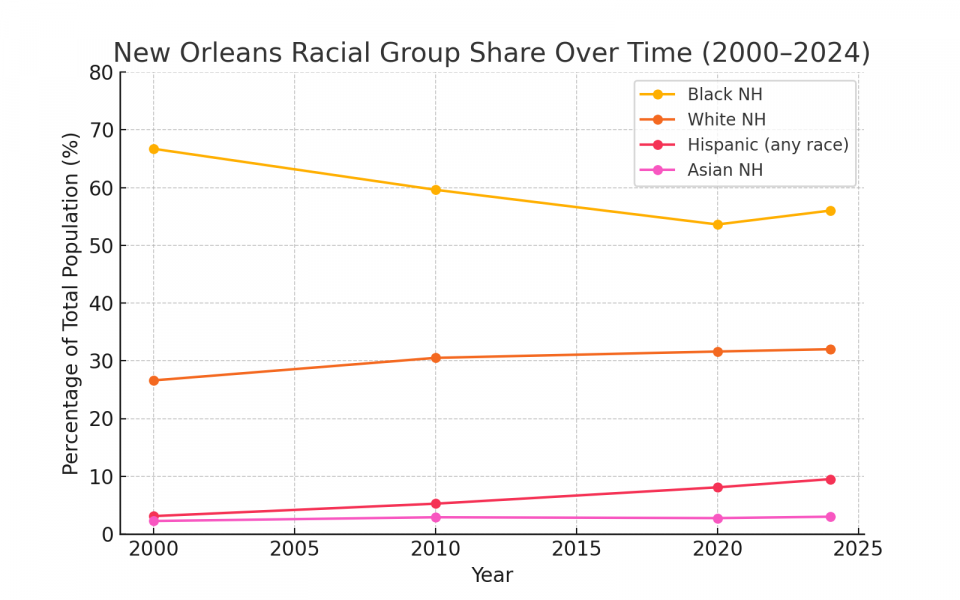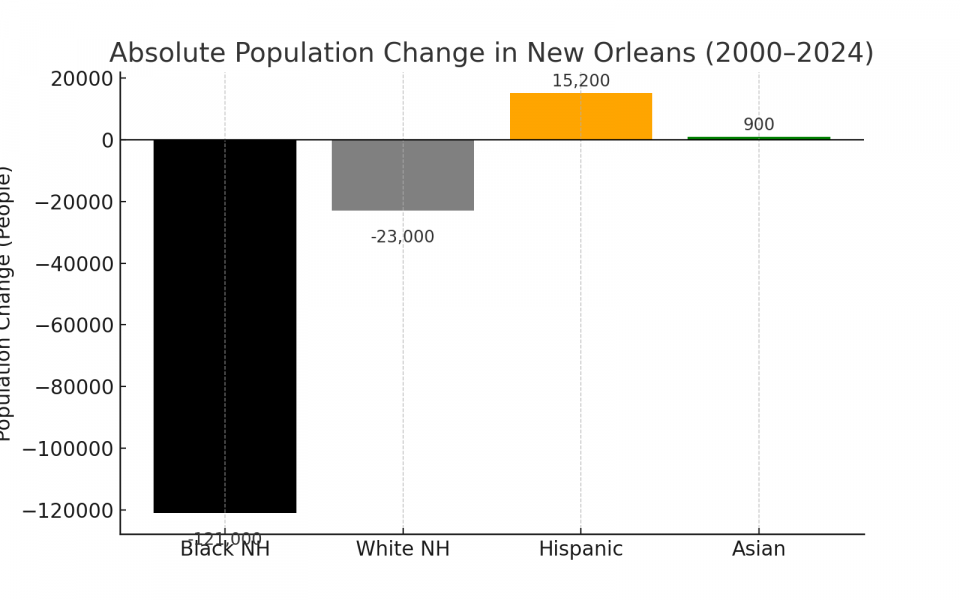Meta Description
Katrina Memorial Series – Episode 1
Remapping Race: How Katrina Reshaped the Faces of New Orleans
August is upon us, and for many New Orleanians, that familiar hurricane anxiety starts to rise. Statistically, August and September are the most active months for hurricanes hitting Louisiana, and those memories from 2005 still feel close. Whether you evacuated to Houston like I did, or stayed in New Orleans, we all share some lingering trauma that this season tends to stir up.
At Think504, we want to take this time to reflect. How has New Orleans changed since that fateful day in 2005? What has been lost, what has been gained, and how have we evolved as a city? This series will explore those questions. New Orleans is undeniably a different place now, and we hope to better understand the changes by looking at the numbers and the stories behind them.
Overview: 2000–2024 Population Shifts
Using Orleans Parish (city) census data, here is the demographic breakdown:
| Year | Total Pop. | Black NH | White NH | Hispanic (any race) | Asian NH |
| 2000 | 484,674 | 323,392 (66.7%) | 128,971 (26.6%) | 14,826 (3.1%) | 10,919 (2.25%) |
| 2010 | 343,829 | 204,866 (59.6%) | 104,770 (30.5%) | 18,051 (5.25%) | 9,883 (2.9%) |
| 2020 | 373,977 | 205,876 (53.6%) | 121,385 (31.6%) | 31,017 (8.08%) | 10,573 (2.75%) |
| 2024* | ~362,000** | ~204,250 (~56%) | ~115,600 (~32%) | ~32,700 (~9–10%) | ~10,800 (~3%) |
* 2024 numbers are projections
** Latest Orleans Parish population estimate ~357,800–362,000
Trend Summary (2000–2024)
- Total population dropped by more than 120,000 people since 2000.
- Black, Non-Hispanic population fell from 67% of the city to about 56% today (–121,000 people).
- White, Non-Hispanic population stayed more stable: 26.6% in 2000 to ~32% now (–23,000 people).
- Hispanic population has nearly tripled in share, from 3% in 2000 to 9–10% now (+15,000+ people).
- Asian population has grown slightly, from 2.3% to about 3%.
Chart 1: Racial Group Share Over Time (2000–2024)

Chart 2: Absolute Population Change Since 2000

Expert Context & Interpretation
- Elizabeth Fussell et al. show that low‑income, predominantly Black neighborhoods bore the brunt of displacement and had slower recovery rates, fueling the drop in Black population.
- Richard Campanella, a well-known New Orleans geographer and historian, and others note that African Americans were overrepresented among flood victims and displacement zones. Many of the neighborhoods most heavily affected by levee failures and flooding were historically Black, and those areas experienced greater displacement and slower recovery. This reinforces how pre-existing spatial inequality shaped the disaster’s impact and the recovery process.
- A 2025 Data Center report confirms the city has 121,142 fewer Black residents and 23,344 fewer white residents compared to 2000, alongside 15,284 more Hispanic residents.
- Newer residents—Hispanic, Asian, and multiracial—are reshaping the cultural and economic fabric, particularly as many arrived as rebuilding laborers and stayed to open businesses and restaurants.
Related: Katrina at 20: What Happened to Our Poorest People
Cultural Shifts & the Culinary Lens
In the coming weeks we’ll feature:
- Profiles of new and influential restaurants opened by Hispanic and Asian owned operators.
- Neighborhood narratives in East/Lower Ninth Ward, Mid‑City, Bywater, and others showing who came back, who stayed, who moved in.
- Voices from the recovery: Black community leaders, immigrant workers, returning public‑housing residents, cultural workers.
- Analysis of policy drivers: housing redevelopment, economic incentives, gentrification, labor markets.
Invitation to Our Weekly Series
This is the first installment in our Remapping New Orleans series—a weekly examination of how Katrina reshaped not just geography, but who we are.
Next week: “Rice, Tacos & Gumbo: The Rise of Latino and Asian Cuisine Post‑Katrina”—we’ll take readers inside restaurants that are cultural signposts of demographic change.

